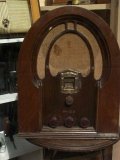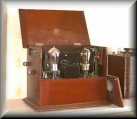EXPERIMENTAL radio drama pieces
Why work on experimental pieces?
See Bull, Michael and Back, Les, The Auditory Culture Reader, 2003, New York: Berg
David Sonnenschein, Sound Design. The Expressive Power of Music, Voice, and Sound Effects in Cinema, 2001, McNaughton & Gunn, Michigan.
| How and why does sound become significant to us? |
| What happens when we reject narrative to convey meaning and feeling? |
| What happens when we counter most radio drama conventions? |
| Examine bits and pieces of discontinuous time and space, and of times and spaces that do not touch each other (discontiguous) |
| Examine geographies that can be navigated in different ways. Different soundscapes. |
| Disorient the listener - getting lost - new realms of sound |
| Non-narrative, reflexive, non-realist - as experimental cinema |
| Interactive relationships with the listener |
| Working with discontinuity and even disorientation |
|
The challenge of listening to an experimental piece is that it is a challenge to gain understanding. Here is Robert Lepage, the experimental performance director and performer: 'if you want to have an audience embrace what you do, you have to offer them a workout, not forced entertainment'. (Goddu, Jenn. "Quebec Director Lepage's Newest Play a Work Under Construction." Canadian Press Newswire, 1998, 1-3) Also on Robert Lepage - http://lacaserne.net/index2.php/robertlepage/ An experimental film, is usually low-budget or indie film. It challenges conventions of filmmaking by using camera techniques, imagery, sound, editing, and/or acting in unusual or never-before-seen ways. (Also avante-garde, art films) |
FIRST STEPS
| LISTEN TO AS MANY EXPERIMENTAL PIECES AS YOU CAN: For example, BBC Radio 3 series 'Between the Ears' - see information at http://www.bbc.co.uk/radio3/betweentheears/; and London's innovative radio station, Resonance FM at http://www.resonancefm.com/audio.htm (and you can also listen on line). |
| NOTE: For an experimental piece, a "focussed-in" listening ("zoomed-in" listening) is essential, and you demand that full attention of your audience. Your piece has to be listened to in a particular way - on good-quality headphones (and binaural?), as an art installation - on speakers in a particular space as in an art gallery with the listeners in a particular area. |
| If for broadcast, you probably should respect BBC Editorial Guidelines |
STRUCTURE
| OVERALL STRUCTURE: Think through overall structure. How can you give markers to parts of this structure, and to give the listeners the feeling of that structure? |
| Opening and closing are so important. OPENING: You have to give some signal about your KEY CONCEPT. CLOSING: You have to signal closure. (By repeating some motif from the beginning?) |
| Take care with the scene boundaries or transitions - how you go from scene to scene. You may be so busy with the scenes or sections, that you do not devote time to how the scenes connect, and how this all fits together - rather like a piece of music. You must use the scene boundaries to help create the rhythm of the whole. Also scene boundaries - more |
STRUCTURE - more
| Look at the structure of your experimental piece: STORYBOARD IT IN BOXES (LIKE A CARTOON) |
| PLOT THE STRUCTURE LIKE A MAP WITH CONTOUR LINES (highs and lows) |
| Find out the INTENSE SECTIONS (COMPRESSING A LOT OF MEANING AND/OR SOUND EVENTS = density) + 'PURIFYING MOMENTS' (SILENCES) + TRANSITIONS + other sections |
| MAP YOUR PIECE - INTENSE SECTIONS + 'PURIFYING MOMENTS' + TRANSITIONS + other sections |
|
DENSITY - INTENSE COMPRESSION - PURIFYING MOMENTS moving in and out of sections of intense compression, the density, in time - and relaxed intervals between these - some parts with high density of events and some not 'purifying moments' - which retune our ears and prepare us for the next 'movement' - "zone out" for a while, and then "tune back in" The problem with human perceptions is that they become automatic with repetition: they engage less and less of the brain. |
| Map the piece as a journey - start to finish. How do you want to place your listeners at the start? Where do you want them to end at? What are the places you wish them to visit? Are there detours? Side paths? Is the journey one straight line? |
| Find your large-scale goals. Find your points of arrival, "climaxes" and the like. |
STRUCTURE - THE BEGINNING OF YOUR EXPERIMENTAL PIECE
| Prologue - I strongly advise this for some experimental pieces. Pick out the two or three main themes and/or significant sounds and music notes (themes or leitmotifs). |
| The prologue also helps you set the mood of the piece. In working with an experimental piece, the listener needs to be 'settled in', and informed about the style, mood, 'colour' of the piece. |
| It is too easy to neglect the hard work of this prologue or overture, and not to undertake it. But it will add maturity and sophistication to your work. It forces you to go to the essence of the piece. It also forces you to communicate with the listeners - to site them - not so much to reassure them, as to get them quickly into your work. |
| See below - 'The Company of Wolves' - using the wolf howl, FX of rushing, a laugh, a sampled audio section from a children's version of 'Little Red Riding Hood' - to establish the contrariness and sophistication of this script by Angela Carter. |
STRUCTURE - THE ENDING OF YOUR EXPERIMENTAL PIECE
| ring composition - the beginning and the ending are connected (like a snake swallowing its own tail) |
|
(PAGE IN CONSTRUCTION) NOTES Use single significant words. Looping OR TRY 'FLATFORM' See and listen to 'Homecoming', 9-3-2002, 45 minutes, producer Antony Pitts, Between the Ears - Radio 3 - for FLATFORM Flatform lacks an overall arch or any sense of everything being an integral part of an overall hierarchical formal design (I DO NOT PREFER a through-composed piece - that is a piece which has no pauses (the FLATFORM type - see below at STRUCTURE). There may be a specific reason which grants an exception, as 'slice of life', and then only within a strong concept) . The through-composed FLATFORM type piece is rarely justified. It requires a lot of skill and is a big challenge, however.) OR 'UP-THE-LADDER-TO-THE-TOP' accretive (building bit by bit), tension-building form = building up all the way to climax You reveal the key point about the piece at the end, and then the listener puts it all together and makes sense of it in the final section. WITH vivid, individuated, sonic moments and their local relations To make a particular point - for a short spoken section -
use an antique ticking clock underneath, to emphasise the importance
of the point. In the key explanation section - where you explain the KEY
DETAILS of the "The victim's blood spatter pattern, the MO of the typical aggressor, all lead to this - Fatal Attraction Syndrome (Fatal Attraction Syndrome - repeated under but with a short delay so there is a slight overlap) - the sad and fatal result of obsessive love ('obsessive love' repeated just slightly ditto) - not just post-romantic bunny-boiling but a downward spiral into loneliness and unattractive violence ('loneliness and unattractive violence' - ditto) + use underscoring music and effects. See underscoring music - chords AB - etc, in SOUND BOX. |
TECHNIQUES YOU CAN USE
| TECHNIQUE YOU CAN USE: Single significant words. |
| TECHNIQUE YOU CAN USE: Overlapping dialogue |
| TECHNIQUE YOU CAN USE: Overlapping and repeating same key words and phrases. |
| TECHNIQUE YOU CAN USE: Music - with repeating beat to give rhythm to whole - underscoring music - drum and bass underscoring (for example) |
| TECHNIQUE YOU CAN USE: chaining sentences - (characters or character and narrator) |
| Narrator - if this could suit the piece - I strongly advise using a narrator. This gives a double view of the piece PLUS the Narrator relates directly to the listener ('you' - the directness of radio). It also allows you to use a knowing, ironic Narrator, who is all-knowing, who knows the outcome. The Narrator could be a main character in the story - and looking back at these transforming experiences. Think of first-person short stories and novels. The Narrator is also in a different acoustic - again this gives contrast to your overall design. Use microphone position two possibly? Or the 'voice in the mind' (position one)? |
| Look at my comments on a student's adaptation of 'The Company of Wolves'. |
Concepts
| Think about sound itself. |
Learn about radio drama techniques in my book -
Beck, Alan, Radio Acting, London: A & C Black (1997) ISBN 0-7136-4631-4
|
|



